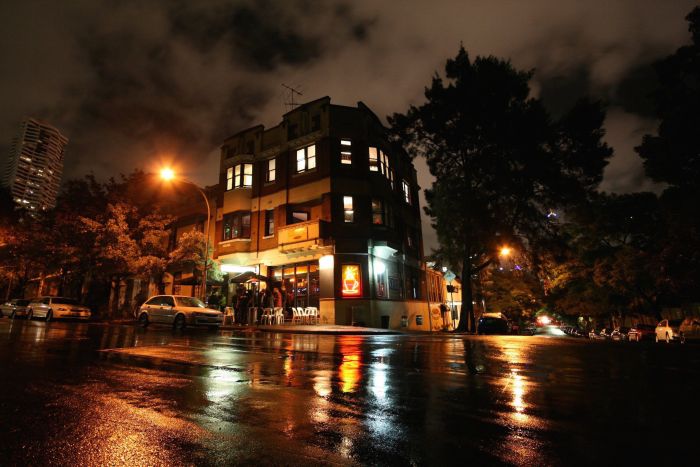Australian author and playwright Louis Nowra thinks yes: but there’s a rider. To get rid of public housing in Millers Point the NSW government over-ruled opposition from the City of Sydney. In Woolloomooloo the federal government also has a say. “So, if a Labor government is in [power], there’s no way.”
Nowra’s new book Woolloomooloo: A Biography, launched on March 13, explores the history, people and streets of one of Sydney’s most notorious and eclectic suburbs.
Nowra, who lives with his wife, the author Mandy Sayer, on the boundary between Woolloomooloo and Kings Cross, wanted to capture the spirit and “Chaucerian richness” of his suburb before it evanesced.
“During my history there, I can see buildings that are now gone,” he said at an author talk in Randwick Library on March 22. “They’re ghosts.”
Woolloomooloo was a highly significant place to the Gadigal people for ceremonies, hunting, camping and fishing well before it was gazetted as a Sydney suburb by the area’s non-indigenous decision-makers in 1848.
The suburb has always been a dumping ground for the poor, Nowra says. It also has a reputation for profanity, crime, misery, gambling houses and brutal people. He describes Woolloomooloo in 1945 as a “tight community” of “sly grog sellers, whores, gangsters, bashers, beggars, blind men, good people, bad people, cruel and kind people, drunkards and the devoutly religious”.
In 2017, he says, the community is still close, and extraordinarily diverse – though not without problems. Two major issues are the aggression associated with the use of the methamphetamine ice; and the unpredictability of mentally ill people who medicate erratically, and whose numbers have increased since the asylums around Sydney were shut down.
Nowra believes there is probably nowhere else in Sydney with such a glaring disparity between rich and poor. “You have people who live on the finger wharf – which is like a quarantine station for the wealthy – who pay millions of dollars for their apartments,” he says. “Meanwhile half the families living in the public housing exist on less than $500 a week.”
Despite these inequities, Nowra loves his “raw” and “unvarnished” community for the way it absorbs and cares for people – for how “everybody coexists with everybody else”. “This is a wonderful area,” he says. “It’s very different. It’s very colourful. Sometimes very dramatic. And sometimes very sad. But it appears to me that this is a place that doesn’t ignore people who are hurt, or are in poverty.”
The Old Fitzroy crew
The beating heart of this biography is the crew Nowra drinks with each afternoon at the Old Fitzroy Hotel on Dowling Street – most of whom, like Nowra, were brought up in public housing.
Crew member “Woolley” distributes OzHarvest food to the housebound, visits the sick and acts as the urban equivalent to the bush telegraph because he always knows what’s going on.
We also meet, Rick, Aboriginal Tony, Kate, “Tickles” and several others, including Nowra’s Chihuahua Coco (who barks incessantly if Nowra drinks more than four white wines), and former Les Girls performer, Ayesha (who sounds fearsome but is my favourite).
As Nowra explains it: “Her diva attitude is the weapon of someone who has had to be brave. Unlike gay men who remained in the closet, drag queens like Ayesha were performing as women in an era of ridicule, even physical violence.”
Grisly tales
Nowra has used his playwright’s instinct to choose a wealth of grisly tales and unusual sights from Woolloomooloo’s history to include in this suburban odyssey. Most are fascinating (and a bit disturbing) so here’s a sample: The woman who ran up stairs with pins and needles in her mouth and accidentally swallowed them and for the next three weeks they emerged from her throat; the Plunkett Street students who hurled live rats at one another; the hot air balloon that exploded and plummeted at the corner of Palmer and William streets burning houses; and the gang rape of a woman, dubbed the Woolloomooloo Outrage, that shocked the nation and motivated its moralists.
Nowra also includes some superb descriptions of walking the suburb’s lanes and streets as a flâneur charmed by its people and architecture, and discovering its hidden oases, including some lush and lovely gardens.
Public housing priority
It was on the heels of a pivotal local protest in October 1972 that the NSW Builders Labourers Federation instituted a Green Ban in Woolloomooloo. Newly elected Prime Minister, Gough Whitlam, kept his pre-election promise that Woolloomooloo would remain residential and injected $17 million to ensure 60 per cent or more of the housing would be devoted to low-income earners.
When the Green Bans were lifted in 1975, regeneration began. Once completed, urban planners from across the world flocked to Woolloomooloo to study its success, which included the way the city council sought and respected the opinions of the community.
“A suburb once notorious for crime, poverty and hopelessness had become an international yardstick for community consultation and planning,” Nowra writes. And still, today, 60 to 65 per cent of people in Woolloomooloo live in public housing.
Nowra says Woolloomooloo’s proximity to the city means it is earmarked as a place for young professionals, which will propel the push for its redevelopment. As he told the Sydney Morning Herald in early March, “They’ll let the public housing run down. It’s easy to get rid of the working class, the underclass. Money always talks in Sydney.”
The subtext lurking in this marvellous biography: Pound the pavements of this unique and historically significant suburb while you can (book in hand). Watch carefully and, if money speaks in ways that threaten the area’s diversity, add your voice to the movement to save it.





